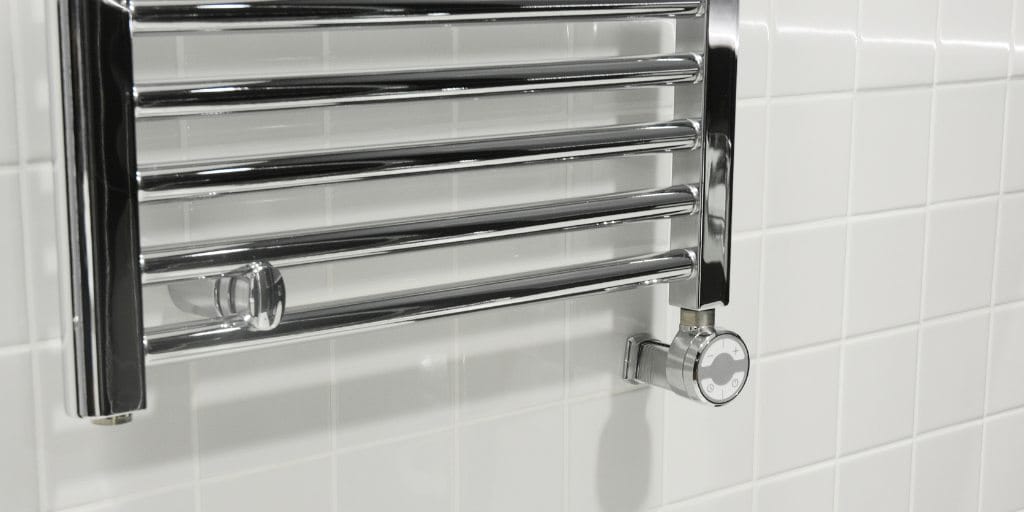There’s nothing worse than getting out of the bath or shower and being absolutely freezing! Stepping onto a cold tile floor with wet feet can send shivers down your spine, and wrapping yourself in a chilly towel hardly feels like a luxurious end to a relaxing soak. But fear not; creating a cosy, warm bathroom environment is easier than you might think.
Choosing the right heating solution can transform your bathroom into a haven of warmth and comfort, ensuring that stepping out of the shower feels just as pleasant as being in it. In this blog, we’ll be looking at different bathroom heating solutions, so you can ensure that your bathroom is always warm and inviting.
Underfloor heating
Underfloor heating has certainly gained a lot of popularity for its ability to evenly distribute heat across the floor, providing a luxurious warmth that radiates throughout the room. It’s a particularly favoured choice for bathrooms, as they tend to have colder floors thanks to tiling or vinyl options.
There are two main types of underfloor heating systems to consider:
Water-based underfloor heating
This system is typically installed during the construction phase of a new build or major renovation. It integrates with your central heating system and works by circulating warm water through pipes laid beneath the floor.
Pros: Provides consistent, gentle heat throughout the room. It can also be highly efficient when connected to a modern, energy-efficient boiler.
Cons: Difficult and expensive to retrofit in existing bathrooms due to the extensive installation process.
Electric underfloor heating
This system consists of heating cables or mats installed beneath the flooring. It operates independently of your central heating system and is controlled via a thermostat.
Pros: Easier to install in existing bathrooms as it doesn’t require major structural changes, plus it provides quick heat-up times.
Cons: Can be more costly to run compared to water-based systems, especially in larger bathrooms.
Heated towel rails
Heated towel rails have become a favourite in many bathrooms, and for good reason. They offer a dual purpose of heating the bathroom while keeping towels toasty and dry! If you’re thinking about opting for a heated towel rail, here’s what you need to know about choosing one:
Types and installation
Heated towel rails can be connected to your central heating system (run off gas boiler) or operate independently with an electric heating element.
Pros: They are often more cost-effective to install and operate compared to underfloor heating.
Cons: Incorrect sizing or installation may result in inadequate heating for the room.
Choosing the right size
It’s important to select a heated towel rail that is appropriately sized for your bathroom. A rail that is too small may not provide sufficient warmth, while one that is too large might waste energy and reduce your bathroom space.
You should consider the heat output when choosing the size. Larger bathrooms require rails with higher watts or kilowatts to effectively heat the space. If you’re not sure what is going to be right for your space, it’s a good idea to talk to professionals like us. We can assess your bathroom, talk about your needs, and make sure you pick the right heating option for your bathroom the first-time round.
Efficiency considerations
You should choose a heated towel rail that heats up quickly to ensure your towels dry efficiently. Not only does this enhance comfort, but it also helps in managing energy costs. Many modern models come equipped with timers or thermostatic controls, giving you the flexibility to adjust heating times and temperatures to suit your needs so your towels are always warm when you need them!
Energy efficiency and environmental impact
As energy efficiency becomes increasingly important, it’s a smart move to consider how your choice of bathroom heating system impacts your comfort, bills and sustainability.
Solar and renewable energy
Embracing solar panels or other renewable energy sources can substantially decrease your heating system’s environmental impact. By using the power of the sun, you not only reduce your carbon footprint but also potentially lower your long-term energy costs.
Thermostatic controls
Opting for a heating system with advanced thermostatic controls is another savvy move. These smart systems allow you to fine-tune heating settings based on occupancy and usage patterns. This means you can step into a perfectly warmed bathroom in the morning or head home from work for a nice warm shower without wasting energy heating an empty room throughout the day!
Insulation
Don’t underestimate the impact of proper insulation. Well-insulated walls and floors can significantly enhance the efficiency of your chosen heating system by helping to reduce heat loss. This not only improves overall performance but also helps maintain a cosy, consistent temperature in your bathroom.
By bringing these energy-efficient practices into your bathroom heating plans, you not only ensure your daily comfort but also contribute positively to environmental conservation. It’s a win-win scenario: a warm, inviting bathroom that’s kinder to both your wallet and the planet!
Do you have questions about bathroom heating, or would you like some more personalised advice? Contact our friendly team today, we’d love to help you create the bathroom of your dreams!

